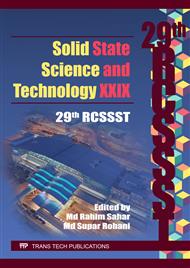p.43
p.48
p.54
p.62
p.67
p.72
p.77
p.82
p.87
Structures and Ligand Field Parameters of Sm3+ Doped Tellurite Glass: Gold Nanoparticles Mediation
Abstract:
Controllable modifications of overall properties of rare-earth doped glasses via gold nanoparticles (Au NPs) mediation prompted gamut research interests. Such glass systems are interesting due to their technological prospects and well as fundamental understanding of surface plasmon resonance effects at metal glass interface responsible for diverse emerging attributes. This motivate us to determine the effects of varying concentration of Au NPs on the structure and ligand field parameters of samarium (Sm3+) doped zinc tellurite glass. Glass samples with composition (79-x)TeO2-20ZnO-1Sm2O3-xAuCl3, where 0 ≤ x ≤ 0.10 mol% are prepared using melt quenching method. X-ray diffraction pattern of all glasses confirmed their amorphous nature. Transmission electron microscopic images verified the existence of Au NPs in a glass matrix matrix with an average size of 10.52 nm. Two surface plasmons resonance band of gold are probed at 652 and 715 nm. Using the UV-Vis absorption spectral data, quantities such as nephelauxetic ratio, bonding parameter and Racah parameters are evaluated. Both bonding parameter and nephelauxetic ratio revealed a reduction with increasing concentration of Au NPs, where decrease in the ionic bonding between Sm3+ and surrounding ligand have clearly indicated an enhancement in the covalency. The values of Racah parameters are decreased as the concentration of Au NPs are increased. The observed reduction in the nephelauxetic function is attributed to the weakening of the localized d-electrons aroused from overlapping d-orbital and ligand orbital. Furthermore, the Raman spectra displayed the structural modification in terms of TeO4 trigonal bipyramidal (tbp) unit, where many TeO4 tbp units are converted into their TeO3 trigonal pyramid (tp) counterparts. Raman bands are found to be located around 102-105 cm-1, 420-424 cm-1, 657-661 cm-1 and 729-736 cm-1. Results are analyzed and compared. Present glass composition is asserted to be useful for the development of photonic devices.
Info:
Periodical:
Pages:
67-71
Citation:
Online since:
October 2017
Authors:
Price:
Сopyright:
© 2017 Trans Tech Publications Ltd. All Rights Reserved
Share:
Citation:


